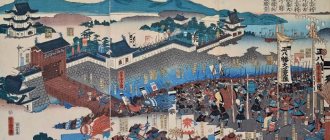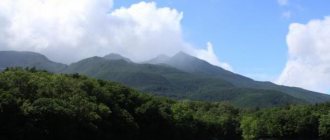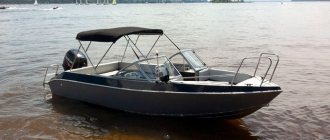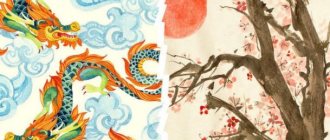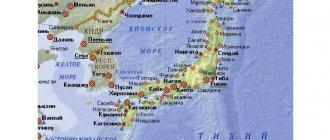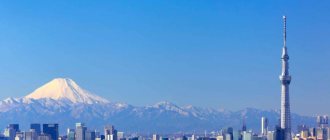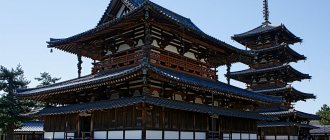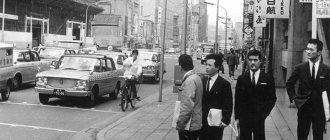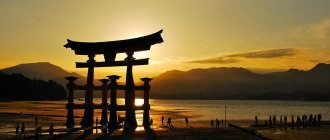Everything about Japan.
Japan is a country located on islands, most of which are of volcanic origin. The largest are Hokkaido, Honshu, Shikoku, Kyushu. Most cities are concentrated on them. Japan is located in East Asia. It is surrounded by China, Taiwan, North and South Korea, and Russia. The archipelago is washed by the Sea of Okhotsk, East China and Japan. The highest point of the Japanese archipelago is Mount Fuji, which often becomes the subject of poetry.
1.Name.
The word “Japan” came to us from the German language. The country is actually called Nihon Koku. This name is official. It is used on money, documents and postage stamps. There is another option - Nippon koku. It is most often heard in spoken language. The word "nihon" is translated as "source of the sun." Hence the popular name Land of the Rising Sun.
2.Management.
In Japan, both parliament and constitution operate simultaneously, but at the same time, part of the power belongs to the emperor.
considered a symbol of the country's unity.
The history of the imperial family originates from mythology. According to ancient legends, the first emperor was of divine origin. Parliament consists of 480 deputies who are elected for a term of 4 years and are called the House of Representatives. The House of Councilors consists of only 242 seats, the electoral term of which is 6 years. Universal suffrage applies to all residents of Japan over 20 years of age. Representatives are selected by secret ballot. There are two parties in Japan - the social liberal Democratic Party and the conservative Liberal Democratic Party. The executive branch is headed by the Prime Minister of Japan, who is chosen by the Emperor. He forms the composition of the government. The court in Japan consists of four levels. The highest of them is the Supreme Court. He can repeal legal provisions that are contrary to the constitution. Representatives of this court are appointed by the emperor, while all others are appointed by the Cabinet of Ministers. The appellate courts are the highest courts, followed by the district courts, which play the role of the rest. The simplest disciplinary courts. 3. General.
Japan is a country that has always been difficult for many foreigners to understand.
Her amazing legacy excites many. The traditions are very different from the European ones we are used to. This is often what catches your eye when you first visit a country. The people there are extremely friendly, they always want to see a smile on the face of others. The Japanese are open and at the same time value personal space. You can't get too close to them, you need to keep your distance.
Many people are familiar with Japanese traditions and society. Anime, action figures and cosplay are very popular these days. Gradually, ancient culture and mythology begins to penetrate into other countries, which makes it much clearer and easier for representatives of other nations. Anime is one of the animation genres that has become extremely popular. He captivates many with his unusualness. It can be said that people find charm in a new form. Manga has also become very popular - hand-drawn comics that are read from left to right. A short story about Japan (option 2)
A short story about Japan (option 3)
Source: www.istmira.com
Mysterious and incomprehensible to European people, Japan for centuries was isolated from the outside world by a curtain stronger than iron and constantly attracted foreigners with its harsh beauty, sophistication and asceticism, which, when combined, give rise to the unique charm of this country, called the “Land of the Rising Sun”.
Japan is a small East Asian island state located in the Pacific Ocean off the coast of Russia.
Its territory of Japan is formed by 6852 islands, 97% of the area of which is made up of the 4 largest islands - Honshu, Hokkaido, Kyushu and Shikoku. The capital of the state is the city of Tokyo, which, together with the adjacent metropolitan area, is the largest city in the world with a population of 30 million people. The official language of the state is Japanese, but almost everyone will be able to answer you in English. The national currency is the Japanese yen and the capital is Tokyo.
The history of Japan is as complex as its writing. It is known that people settled on these islands as early as 40 thousand years BC. - in those days, the population of the islands lived by gathering and hunting. Basic technologies like flood rice cultivation, the potter's wheel, and metalworking appeared in 500 BC. having been introduced by immigrants from Korea and China. 10 centuries later, in 538, Buddhism, which also came from the mainland, spreads across Japan, and a state with its own set of laws is formed. At the end of the 12th century, Japanese feudalism was formed and internecine wars between dynasties began - an indispensable attribute of the feudal system, and by 1467 a civil war broke out. At the beginning of the 16th century, Portuguese sailors reached the shores of Japan, putting an end to the cultural and trade isolation of the country.
They bring with them firearms, by exchanging which one of the shoguns managed to turn the tide of the war and almost completely unite the country, which he was prevented from doing by sudden death from an excess of iron in the body.
Shogun Tokugawa, who replaced the late one, moved the country's capital to the territory of modern Tokyo and began to pursue a policy of self-isolation that lasted for 2 centuries. All this time, Europeans, in particular the Dutch, were studying Japan and settled on the small artificial island of Dejima in Nagasaki harbor. The next period of isolation was ended not by anyone, but by the Americans, who sailed on black ships and forced the government to open the borders. Nothing good came of this again - several unequal treaties with Western countries provoked a large-scale crisis that resulted in another civil war (Boshin), as a result of which the shogunates were abolished and a constitutional monarchy led by the emperor was returned. Thanks to the new policy and leadership, as well as established connections with the outside world, the country began to develop rapidly, entering the era of industrialization, and victories in the Sino-Japanese and Russian-Japanese war contributed to the growth of the state’s military ambitions. In 1937, Japan attacked China, and in 1941 - the United States, bombing a military base in Pearl Harbor, for which in August 1945 America dropped 2 nuclear bombs on the country's major cities - Hiroshima and Nagasaki. This terrible blow forces Japan to sign a complete unconditional surrender and adopt a new policy - a policy of pacifism, which prohibits the country from having an army or declaring war. The new policy benefited the country, allowing it to demonstrate record economic growth (10% per year) for 4 decades. Growth was interrupted by the 1991 crisis, from which the country emerged only at the beginning of 2000. Japan is located on an archipelago that includes about 7,000 islands of various sizes, the largest of which are Hokkaido, Honshu, Shikoku and Kyushu. Most of the country's territory (75%) is highlands and mid-altitude mountains.
The country's highest point is the picturesque Mount Fuji (3776 m). Despite the relatively small size of the territory, Japan has several distinct climatic zones, and if the northern regions are characterized by frosty winters and cool summers, the southern ones, on the contrary, lie in a tropical climate zone with hot summers and huge amounts of precipitation, which is expressed in the presence of a season rains and the frequent occurrence of typhoons. Also, the territory of Japan is characterized by very high seismic activity of the earth’s crust: up to 1,500 earthquakes with a magnitude of 4 to 6 occur per year. Japan is extremely poor in natural resources . In principle, the country has proven reserves of coal, oil, iron and copper ores, as well as deposits of precious metals, but they are very small.
Japan's main resource is its population of 127 million (10th in the world), 87% of which live in cities. The vast majority are Japanese. The remaining 2% come from Korea, China, the Philippines and some other regions.
The Japanese economy ranks third in the world ($5,390 billion in 2010), losing second place to China, which is confidently regaining its position. The basis of the country's prosperity is the sphere of banking services, insurance, real estate and telecommunications and, of course, production of various levels - from microelectronics to heavy engineering. The country produces a huge number of products under global brands such as Toyota, Mitsubishi, Honda, Canon, Nintendo and many others. According to the Big Mac Index, workers in Japan earn the highest hourly wages in the world, and the Tokyo Stock Exchange is one of the world's three major trading floors.
Source: work-n-travel.ru
Japan Post Report
In the 1st century BC. Until the 3rd, the Japanese tribes gradually began to unite together. The Yamato tribe, the 1st dynasty of emperors, took supremacy over the tribes.
Until 710, there was no permanent capital in Japan due to the fact that each subsequent emperor, along with his retinue, moved to a new place according to Shinto customs - it was impossible to live where the previous emperor was buried. In 710, the capital of Heijō-kyō was established. In the 9th century, Japan stopped all contact with China (China had previously been the standard for the life of the Japanese), which gave it impetus for independent development in all spheres of life (from home life to religion).
In the 12th century, dual power was established - the emperor controlled external traditions, but the basic right to govern the country remained in the hands of the military (shoguns).
In 1274, after conquering China, the Mongols decided to seize Japanese lands. They almost managed to do this, but a typhoon that covered the coast of the islands smashed their fleet into pieces. In 1281, a second attempt by the Mongols to capture Japan also failed - a typhoon again destroyed their fleet.
Muromachi period
In 1333 there was a division of power. The incumbent Emperor Godaigo escapes the capital of Kyoto and establishes a new capital in Yoshino, creating the Southern Court. At this time, Shogun Ashikaga becomes emperor in Kyoto and establishes the Northern Court. From that moment on, 2 emperors tried to rule the country. However, due to constant wars between other military clans, both Ashigaka and subsequent emperors from his clan did not have full power. As a result, in 1447 the Ashigaka clan was overthrown and the capital Kyoto was destroyed. Having lost their center of power, each military clan began to impose its own rules on its subject territories. From that moment on, the feudal fragmentation of the country began, which lasted 100 years.
Europeans began to establish contact with Japan - the first firearms were imported, and an attempt was made by missionaries to convert the Japanese to Christianity.
Azuchi-Momoyama period
In 1573, the last shogun of the Ashikaga clan was expelled. The period of feudal fragmentation was over, and from that moment on, under the leadership of Oda Nabunaga, the unification of the lands began. After the death of Nabunaga, the unification of lands was continued by Toyotomi Hideyoshi. He banned monks and peasants from having weapons, forced samurai to become city dwellers, conducted the first census, and banned Christianity. He tried to conquer Korea and China, but suddenly died and the military campaign against these countries automatically stopped. Until the 20th century, Japan did not attack other states in its first war.
Edo period
In 1603, shogun Tokugawa Ieyasu came to power and completed the unification of the clans into a single country. He created a 5-class system, according to which the population was divided into samurai, artisans, merchants, peasants and eta. This one is the Japanese who did the most obscene and humiliating work.
and the administration of the Tokugawa, a period of calm and peace began. The revolt that the peasants tried to raise under the slogans of Christianity was quickly suppressed. From that moment on, a decree was signed that prohibited Europeans from entering Japanese lands. The country's voluntary self-isolation has begun. But in 1853, the American officer Parry forced the Japanese to open the way for trade. The dissatisfaction of the country's residents with self-isolation and many other problems led to the shogun being overthrown from the throne, and power passed into the hands of the emperor.
Meiji period
The new emperor makes the city of Tokyo the main city of Japan. An intensive transformation of the country began: class inequality was abolished, freedom of religion was declared, and compulsory primary education was introduced. The country has completely opened its doors to foreigners - student exchanges have begun. In 1889, the country's first Constitution was adopted.
A war began with Russia, where it eventually wins and expands its territorial borders. Annexes Korea.
World War 2
In 1937, the Sino-Japanese War began. It ended in 1945 with the defeat of Japan. Immediately after the war, the United States carried out its first nuclear weapons attack on humans, dropping bombs on Hirashima and Nagasaki. The country was in distress. The United States took advantage of this and carried out reforms in Japan: a new Constitution was adopted, which abolished the country's armed forces.
In 1952, Japan, according to the Peace Treaty, freed itself from US occupation and began to restore ties with the Soviet Union and China. The country's economy began to boom.
2nd, 3rd, 4th grade, the world around us, briefly
Option 2
Japan is the most mysterious and unique country. This is a completely different world in which the past and future are inextricably linked. Such a contrast cannot go unnoticed by a tourist. When thousand-year-old temples stand next to skyscrapers, it is a fascinating sight.
Japan is an island country located in the Pacific Ocean. The largest islands are Honshu, Hokkaido, Kyushu and Shikoku. Basically, almost all of Japan's islands are either mountainous or volcanic. The largest volcano is Fuji. The capital is Tokyo, which is located in the southeast of the island of Honshu. It is the most crowded city in the world, home to more than 12 million people. It is also one of the richest cities.
Japanese technology has always been one of the best in the world. The creation of robotics, cars, and household appliances has always attracted great attention from connoisseurs of quality products. And this is no coincidence. Japanese craftsmen differ in their approach to business from other manufacturers in their mentality. Making a low-quality product is considered a great disgrace for the Japanese. Previously, during the times of the samurai, being disgraced was considered worse than death; in order to avoid such a fate, the Japanese sacrificed themselves in the traditional “hara-kiri” method. This remains in the memory of many generations for many decades. Therefore, their attitude to the quality of their products comes first. After all, making the best product in the world is a matter of honor for the Japanese.
The main religion in Japan, among others, is Buddhism. The Zen school, which professes the true power of the Buddha, has become widespread. Its basis is meditation. Peace of mind and balance helps the Japanese find the necessary inner strength, which helps them realize their best qualities. On this basis, flower decoration techniques, tea ceremony, and garden art are cultivated. The development of martial arts, painting and poetry - all this was also laid down for many years by the Zen school. Also, one cannot fail to mention Bushido (“the way of war”). This is a moral and ethical teaching about the norms of behavior of samurai. The source of this movement was Confucianism. People believed that death is the path to purification and reincarnation into another, better life. An example of mass suicide was the two world wars in which the Japanese took a direct part. Suicide pilots, called kamikazes, went to their deaths knowing that everything was being done for good and that life after death would be reborn in its best reflection.
Resources
The country has very low resource potential. Almost all natural resources are in great short supply, and especially mineral ones. And although various types of minerals are present in the country, the reserves of these resources are minimal, and the needs of such countries are great. Therefore, the country is forced to import almost all minerals from neighboring countries, which are more generously endowed with nature. more details
Japan is a unique country. Indeed, despite the dependence on imported resources, the industrial approach to production, as well as the potential itself, is enormous. This is how ferrous and non-ferrous metallurgy, mechanical engineering (Japanese cars are known all over the world as an example of reliability), and shipbuilding developed. Many residential and administrative facilities are being built, the chemical and petrochemical industries are at the peak of their development. The country has achieved great achievements in the field of digital technologies.
As for agriculture, on soils on which nothing grows at all, Japanese farmers, using modern technologies, grow vegetables and fruits in fairly large quantities. more details
Report about Japan
Japan is located on an island archipelago in eastern Asia. There are four main islands in this archipelago: Hokkaido, Honshu, Shikoku and Kyushu. In addition, it includes about 4,000 small islands. The area of the Japanese state is approximately 377 square meters. km. Japan's closest mainland neighbors are Russia, Korea and China. The capital of this state is the city of Tokyo.
Almost four-fifths of Japan's territory is covered by mountains. The Japanese Alps cut through the center of Japan's largest island, Honshu. The highest peak is Mount Fuji, a cone-shaped volcano considered sacred by many Japanese.
Japan is a pretty dangerous place. Three of the tectonic plates that form the Earth's crust meet nearby and often move against each other, causing earthquakes. About a thousand earthquakes occur in Japan every year. Japan also has about 200 volcanoes, 60 of which are active
The Japanese people have a deep affection for the beauty of the landscape. The ancient Shinto religion states that natural features such as mountains, waterfalls and forests have their own spirits.
Pollution of the natural environment is now closely controlled, but road construction and other human activities have damaged the natural habitats of animals. About 136 species of animal or plant life in Japan are threatened with extinction.
According to the latest data, the population of Japan is already approaching 128 million people. The official language here is, of course, Japanese. The Japanese are famous for their willingness to work very long and hard. Children are taught from a young age to show respect for others, especially parents and superiors. They learn to do what is best for their family or company and worry less about their needs.
Japanese food is very different from food in Western countries. The diet here includes a lot of rice, fish and vegetables, but little meat. With little fat or dairy, this diet is very healthy, helping the Japanese live longer on average than any other people in the world.
Japan is the only country in the world with a ruling emperor. Emperors have no real power, but they are still revered as a symbol of tradition and the unity of the country. At the same time, the emperor is also the High Priest of the Japanese Shinto religion. And the post of High Priest can only be held by a man. Therefore, despite the introduction in modern European monarchies of inheritance according to the principle of primogeniture (when the first child of the monarch becomes the next king, regardless of gender), in Japan inheritance still occurs only through the male line. In connection with this, not long ago there was a dynastic crisis in Japan, and the possibility of changing the order of succession was vigorously discussed, since the two adult sons of the current emperor had only daughters. But in 2006, the emperor's youngest son, Prince Hisahito, was born, and discussions of reform in this area died down.
World War II destroyed the Japanese economy. But the hard work of the Japanese people and technological innovation revived it, making it the second largest economy in the world. The Japanese high-tech industry makes some of the most popular electronic products in the world.
2nd, 3rd, 4th, 7th grade. The world. Geography
Popular message topics
- Animals of the forests
One of the main miracles that nature has created is the forest. After all, it is not only a decoration of our planet, but also a regulator of water balance, and protection of the earth from drought, as well as a natural apparatus that saturates it with oxygen and purifies the air. - City of Orsk
The city of Orsk was built as a fortress to protect the lands of the Kazakhs who joined the Russian Empire, fearing raids on them by nomads. Over time, the city became more and more popular, - Air Pollution
Air pollution is the release into the atmosphere of any substance, such as chemicals or airborne particles, that is harmful to both human and animal health and the health of the wider environment.
